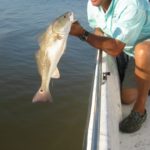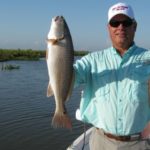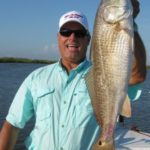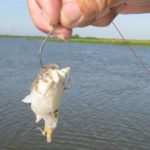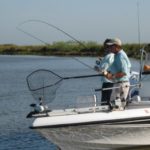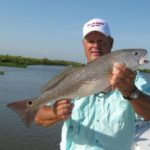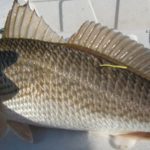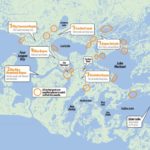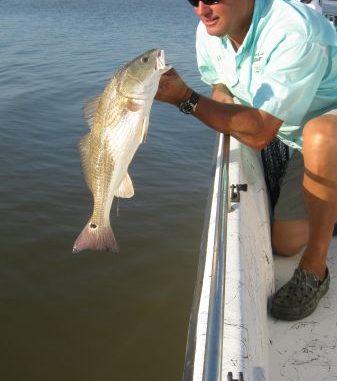
You don’t need a doctorate from the University of Fishing to catch redfish this month. Just head to the bayous near Dularge for non-stop action.
John Wayne once said, “Life is hard. It’s even harder when you’re stupid.”
Me, I’m tired of being stupid when it comes to fishing in September.
Those of us who target speckled trout have long realized that September can be a very tough month. It’s the busiest month for tropical activity, which means it can be very windy, water gets stirred up and muddy, and fish vanish.
And, it’s a transition month, when trout abandon their summer patterns and scatter like birdshot from a short barrel.
The fact is, in September trout can be harder to find than an honest politician.
And me? I keep chasing the elusive specks, burning daylight and fuel, banging my head against the center console and wondering where the fish all went.
It happens every September, and I’m tired of repeating the same cycle over and over, and tired of being stupid.
This year, I decided to end my stupid streak and do something smart. I wanted to go fishing in September and actually catch fish.
So, I called Capt. Bill Lake (985-851-6015) over in Dularge, and invited myself fishing. Lake had been telling me how incredible the redfish action gets there every September, and I wanted to see it for myself.
We met at Lake’s dock alongside Bayou Dularge, and I loaded my gear aboard his 24-foot Blazer Bay Boat. Our destination was the waters of extreme western Terrebonne Parish, where redfish are drawn like moths to flame this time every year.
“Usually the best fishing for redfish in this area begins in late August, and it continues through early October,” Lake said. “Right now all the major waterways in that particular section of marsh are loaded with big reds.”
He said he believes two things account for the attraction.
“One, the waterways there are main migration routes for the big fish and, two, those waterways are deep, and offer cooler water temperatures,” Lake explained. “You know how stifling hot it gets in August and September. Air temperatures and humidity are sweltering, and the water temperatures in September will usually range between 85 and 90 degrees.
“That compels the redfish to seek deeper, cooler water — and moving water — and the waterways we’ll fish provide all of the above. Basically we’ll focus on a small area of the vast Lost Lake estuary, where bayous and canals are anywhere from 12 to 25 feet deep and the deeper, cooler, moving water gets thick with hungry reds. You’ll see: You’ve probably never caught fish faster than you will today.”
Me? I was ready for some of that kind of action.
Our route brought us through Lake Mechant and into the area surrounding Lost Lake, where numerous large bayous twist and turn in their route toward Four League Bay and the Gulf of Mexico. Lake turned into one of the big bayous and ran a short distance to a sharp curve, where he put the bow almost on the shore and stuck the anchor.
“Cracked crab or live minnows are absolutely the baits of choice right now,” he said. “Catch your own or buy them at the dock at Jug’s Bait and Tackle, and keep them alive.
“Live minnows will get the strike. And with the crabs, keep them on ice, and when you’re ready to fish peel off the shell and cut them in half with a sturdy pair of scissors. Bigger crabs you can cut in quarters, and put a piece on your hook.”
Which bait to use depends on your pocketbook.
“I find the live minnows are easier to use than crab, but they’re a lot more expensive,” Lake said, pointing out that crabs sell for about half the price of minnows.
He said rigging is pretty easy.
“I recommend a sturdy No. 4 or No. 5 kahle hook, and use a sliding sinker rig with a ¾- or 1-ounce weight, depending on the current, so you can get all the way to the bottom,” Lake said. “On an average current I use a ¾-ounce weight, but I’ll go to a 1-ounce weight in a strong current.”
We cast our baits toward the middle of the bayou and waited for them to hit bottom.
“I limited out in this exact spot yesterday and left them biting,” he said, “so we shouldn’t have to wait long for the bite.”
But the bite didn’t come. After 15 minutes without a bump, Lake reeled in.
“Let’s go,” he said. “They’ve moved along the bayou, so let’s go find them. When they’re down there, they’ll nail this bait in minutes.
“I’m not going to waste time when I know I can find them stacked up in these turns.”
So we moved down the bayou, only a five-minute ride to another big turn, and he stuck the bow up against the bank. I noticed indentions in the clay bank where boats had pushed up against it recently — clear evidence that anglers were fishing these turns.
This time we didn’t have to wait more than three or four minutes to get a bite.
And once it started, it was non-stop action.
Lake said he will specifically target redfish in five major waterways in late August through October:
Bayou DeCade
Located in the northeast corner of Lost Lake, Bayou De Cade runs all the way back into Lake De Cade.
“Some of the best fishing occurs at the numerous weirs between Lost Lake and Jug Lake,” Lake said. “You can find redfish in Bayou De Cade itself just about anywhere at cuts and other washouts where water is draining into the canal out of the shallow duck ponds.
“And there are some well-defined S curves in Bayou De Cade just before it enters Lost Lake. Reds will stack up in those curves in the month of September. Look for 15 to 20 feet of water for your best chance of success.”
Blue Hammock Bayou
This bayou is south of Lost Lake via Coup Platt Pass.
“This bayou runs from Lake Mechant to Four League Bay, and it holds a huge concentration of redfish all year round,” Lake said.
But there are some high-percentage targets within the bayou, he said.
“The best areas to target reds right now is at the mouth of Four League Bay, the mouth of Rice Bayou and an area known as ‘the Narrows’,” Lake explained. “All of these hotspots have one thing in common: deep holes with a 20- to 25-foot water depths.
“That’s where the reds congregate this month in the cooler water temperatures.”
Lake said anglers aren’t likely to find clear water, but that’s not a problem.
“The water is often stained due to heavy current and a murky Four League Bay, but you should easily find reds along the shorelines between Rice Bayou and Coup Platt Pass,” he said.
Buckskin Bayou
Located off of Blue Hammock Bayou, this bayou runs south into Bay Junop.
“The Buckskin is deep and has an oyster bottom that attracts redfish in big numbers year round,” he said. “The mouth of the Buckskin at Bay Junop is one of the best areas to find big bruiser bronze backs and huge black drum.
“Most of the reds are over the 27-inch mark, so after catching one big fish per person you’ll have to play catch-and-release or fish elsewhere for smaller fish to fill your limit.”
Rice Bayou
Rice Bayou, located in the southwest corner of Lost Lake, connects the lake to Blue Hammock Bayou.
“The mouth of Rice Bayou can be a very productive area to catch reds,” Lake said. “The major problem with this location is that Rice Bayou is murky most of the time and clean water can be hard to find.”
That and current conditions make it less consistent than other areas, he said.
“Usually there is a tremendous current in Rice Bayou and, although there is a healthy population of redfish, conditions have to be right to be successful in this area,” Lake said.
Crochet Canal/Carencro Bayou
Crochet Canal snakes from the north shoreline of Lost Lake and ends at Carencro Bayou. There are a few options in this area, Lake said.
“Once entering Crochet Canal you’ll come to a T,” he said. “Turn right and you’ll enter Carencro Lake. It’s a small, very shallow, brackish water lake with plenty of grass and water lilies. It’s known for some good fishing for both redfish and bass, and it can be very productive.
“Or you can turn left at the T and travel down Big Carencro Bayou until you reach Four League Bay. This is another migration route for the reds as they migrate between Carencro Lake, Four League Bay and Lost Lake. Along this route there are numerous deep holes for reds to seek cooler and deeper water from the searing September heat.”
Once fish are found, action can be frenetic.
“ Just like in all the other areas mentioned, the reds will usually be found in large schools in 15 to 25 feet of water, and catching quick and easy limits is common,” Lake said. “Look for the deeper water in the sharp bends and curves in the bayou and other locations such as the mouth of Big Carencro Bayou at Lost Lake and Four League Bay.”
Meanwhile, we were wailing on the big reds, and they were pummeling our baits at every cast. Lake waved over another boat piloted by Capt. Gerald Ellender, and he anchored nearby so he and his clients could enter the fray.
Every rod was arched with hefty reds on the end of stout line.
“You really need live bait in this deeper water,” Lake said. “Artificial lures are not very productive when fishing in 20- to 25-foot depths.
“I have caught reds on LSU Chubs and gold spoons on those occasions when I’ve found the reds in an absolute feeding frenzy, but live bait is way more consistent and productive. I’ve also caught numerous reds on (4-inch) Gulp! crabs . They will work great when the reds are feeding heavy. Gulp! crabs are very durable, and I’ve caught six to eight fish on a single bait.”
Lake said he usually just flips out his bait and lets it sink to the bottom.
“It’s not necessary to make long casts when fishing deep water, as it’s actually easier to feel the strike with less line out,” he said. “Most of the time the reds are feeding into the current, and you’ll notice slack in your line as the redfish swims upcurrent with your bait.
“A slack line in a stiff, moving current is a sure sign you have a fish on, so reel in the slack and set the hook.
The most important thing to remember when fishing this style is to try your best to be at your favorite spot when the tide switches from an incoming tide to a falling tide. The reds really eat up big time at the switching of a falling tide.
Once the tide gets rolling and falling hard, however, they will shut down and the bite is over.
But I’m convinced there is no place better to catch redfish in late August through early October than the western Lost Lake area.”
So if you want to take the stupid out of September, head over to Dularge. Or give Capt. Lake a call. The reds are waiting.
Capt. Bill Lake can be reached at 985-851-6015 or www.captlake.com.
Destination Information
Bayou Dularge is about a one-hour drive from New Orleans due south of Houma in Terrebonne Parish. Take Highway 315 south from Houma, and basically drive to the end of the road.
Directions from New Orleans:
From New Orleans take Highway 90 south to the Highway 311 exit, and the merge right onto Highway 311. Travel south on Highway 311 for about 10 miles to Highway 182 West. At the light, turn right onto Highway 182 west and travel to the first light. Go through the light, and continue until you cross over the Bayou Dularge Bridge. Merge right after crossing the bridge; go to the stop sign and turn left onto Highway 315. Follow Highway 315 for approximately 18.6 miles to Jugs Bait and Tackle/Jammies Boat Launch.
Directions from Lafayette:
From Lafayette take Interstate 49 East (Highway 90) to the Highway 311 exit, merge right onto Highway 311 and travel south for about 10 miles to Highway 182 West. Turn right onto Highway 182 West and travel to the first light. Pass that light, stay straight and cross over the Bayou Dularge Bridge. Merge right after crossing over the bridge, go to stop sign and turn left onto Highway 315. Follow Highway 315 for about 18 miles.
Maps/Charts
Standard No. 21B – Four League Bay
Marinas
Jugs Bait and Tackle (985-876-1413) is the only game in town. They offer live bait and tackle, fuel, accessories, a restaurant and Jammies Boat Launch (double backdowns).
Guides
Capt. Bill Lake can be reached at 985-851-6015 or www.captlake.com. Other guides also operate out of Dularge. Check the ads in this issue or at www.louisianasportsman.com.
Accommodations
Jug’s has a few rooms for rent, and most of the guides offer overnight accommodations to their charter customers.
